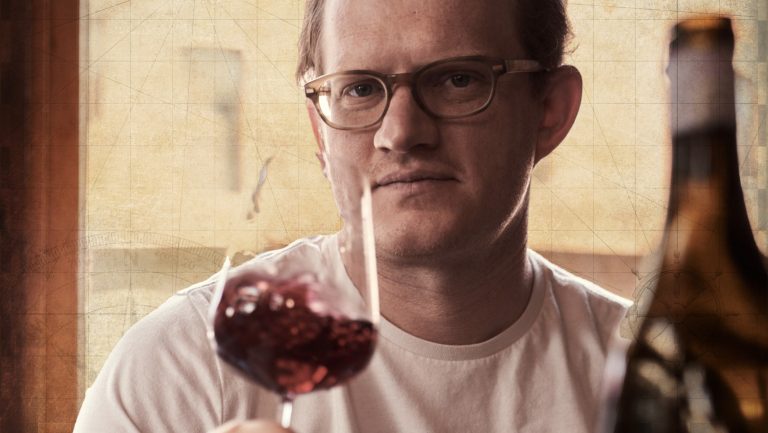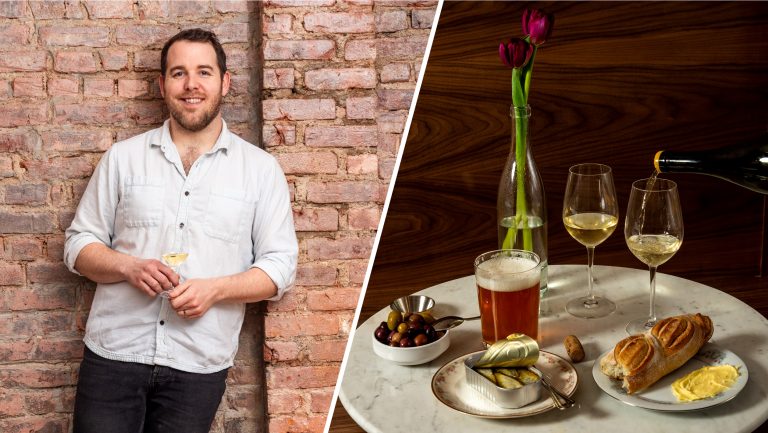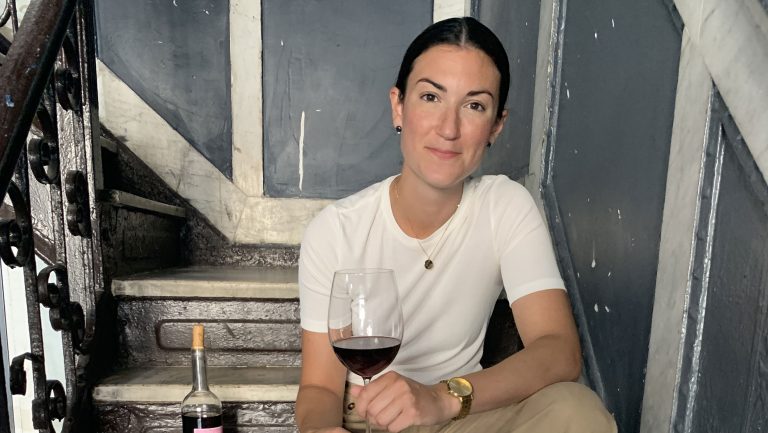In our new series, 5 Bottles I Sold Last Night, sommeliers and wine directors talk about the bottles they’re selling, giving tips and context for making the sale
Blue Hill at Stone Barns is a restaurant in the Stone Barns Center for Food and Agriculture, a not-for-profit farm and education center located in New York’s lower Hudson Valley. The restaurant sources many ingredients directly from the property, as well as from nearby farms, and we work directly with the farms to build a menu on a daily basis.
We don’t have a set menu. Instead, a guest comes in, we have a conversation, and the servers and cooks come up with a unique menu—for each table—based on what we’re getting from Stone Barns and other farms in the Hudson Valley and a bit beyond.

Don’t miss the latest drinks industry news and insights. Sign up for our award-winning newsletters and get insider intel, resources, and trends delivered to your inbox every week.
True to the tasting menu format, the meal starts off with a range of small bites, then progresses into shareable dishes—usually vegetable-focused—followed later in the meal by a more traditional course-by-course experience.
Without a set menu, and given that every table gets a different meal, it’s definitely a challenge to try to fit the wine program into a mold. Now we do what’s called an unconventional pairing—it’s not formulaic; it’s not planned out in advance. The sommeliers totally have the freedom to access the entire wine cellar. If it’s done right, you can actually put together a much more diverse, fun, interactive experience.
Just as the kitchen team and the servers are writing a menu unique to every table, the sommeliers are doing the same thing. We’re looking at our list, looking at our cellar, treating it as one big spice rack, and building a unique experience for every table. Even if, for some reason, two tables in the restaurant get the exact same food menu, they will not get the same wine—or beer, or sherries. Each experience is put together by the somm, in the moment. Here are five bottles I sold last night (the prices listed are what we charge at the restaurant).
1. Analemma Atavus Blanc de Noirs, Columbia Gorge, Washington 2010; $130
The Atavus vineyards have been dry-farmed since the late 1960s. It’s a very old vineyard site for the Pacific Northwest—and for Pinot Noir. The Atavus is made with the méthode champenoise and I think it’s far and away the most complex, tasty, nuanced sparkling wine produced in the U.S.
The beginning of the meal is always interesting because the guest has no idea what they will be eating, and at that point neither do I, although I have a loose sense of the possibilities. To keep up with the pace of the meal early on, I usually lean toward either a really bright and refreshing still white, or a bit of bubbly. With this one table, we started talking about Champagne, and once we settled on a price range I decided to steer them toward the Analemma. It offers a lot more value and nuance than a lot of other Champagnes or sparkling wines at that price point. It’s a great discovery for anyone who knows they like Champagne but also wants to discover other high-quality sparkling wines.
2. Domaine Comte Abbatucci Monte Bianco, Vin de France, Corsica 2013; $180
I like to joke that as much as we do support New York State wines—we carry a vast selection of them, and there are great wines being made here in the state—I will pour entirely local wines the day that Blue Hill does a pop-up in Corsica.
Often when I’m trying to pair wine with the food at Blue Hill, I find myself coming back to the wines in and around the Mediterranean. Abbatucci really takes the cake for Corsican wine; I think it’s the best producer on the island. I sold one of their smaller production wines—the Monte Bianco, which is a 100 percent Sciaccarello from a .6-hectare vineyard site. This sale came about in the middle of the meal, as the table was progressing toward red wine territory. I knew there were thoughts of a Nebbiolo, or perhaps a Brunello, and immediately the Abbatucci came to mind. I had tasted this particular bottling just two weeks earlier and was absolutely stunned. It delivers all the same kind of savory, tomato-like character you find in something like a Sangiovese out of Tuscany—but in a Sciaccarello from Corsica. It also has a great story behind it: The winery is run by a direct descendant, and namesake, of French Revolution hero General Jean-Charles Abbatucci. The estate dates back more than a century, and in the 1960s Antoine Abbatucci created a conservatory for the island’s native grapes that now hosts 18 varieties, which are planted on a single parcel. Since then, his son Jean-Charles has converted the winery to biodynamic production and follows these practices to the full extent. The wine is also a stunning match this time of year for anything with tomatoes in it.
3. Rhys Horseshoe Vineyard Chardonnay, Santa Cruz Mountains, California 2010; $260
The reason I sell this wine is that it’s a knockout example of California Chardonnay. California Chardonnay is definitely not in the cool category of wine by any measure; it fell out of favor a while ago, and people still associate it with being overpowering, opulent, and overtly buttery. I generally don’t like to compare wines to Burgundy—I think it’s a bad habit or a crutch—but I when I tasted the Rhys, it reminded me of the bottlings from Domaine Leflaive in Meursault.
With the guests being in the dark about what they’ll be eating, enthusiasm from the somm goes a long way—as it does in any restaurant. This was a wine I was shocked by, and I think that carries through to the guests. The 2010 vintage from the Horseshoe Vineyard site carries the polish, new oak, and flash you’d expect from New World Chardonnay but has plenty of acidity to back it up. It’s a beautifully balanced wine, and across the board one of the most interesting wines, aromatically, I’ve had from the United States. It wasn’t a terribly hard sell—and they loved the wine.
4. Diamond Creek Red Rock Terrace Cabernet Sauvignon, Diamond Mountain, California 1986; $535
Again, this was a situation where I think my enthusiasm really made the sale. I’m ashamed to say I’ve visited few wineries in the United States, but among those I have checked out is Diamond Creek, which is beautiful and breathtaking. And I think it has one of the best stories in winemaking, which I told to the table: Diamond Creek was founded by this remarkable character, Al Brownstein, who—as I was told—was a student in Paris in the ’40s or ’50s. He fell in love with wine while there, came home, and started working in tech, where he made a small fortune and then decided to pursue winemaking. Over the years he earned his pilot’s license and, at some point, flew to France, made his way to Bordeaux, and started knocking on château doors, asking for vine cuttings. Eventually he got some, which is what he founded Diamond Creek with in 1967. To this day, the winery has not been expanded. Al, and eventually his wife, Boots, who’s a big figure within the California winemaking scene, promised never to expand it but to keep it for the family.
The wine itself is one of my favorites because, while I was studying in France, there was all this talk by French somms about how American wine is too broad and can’t age. It was something I believed; I was totally averse to American wine, especially California Cabs, until I finally started tasting them.
The wine carries these beautiful pyrazinic Cabernet characteristics that I think often get lost, especially in warmer climates—and especially in Napa Valley. Even with the age on this bottle, it has the super-fresh bell pepper characteristic that you’d expect from any Cabernet, but it also has a core of fruit and enough ripeness to present itself as California Cabernet. It’s not trying to be Bordeaux. It’s still a pretty ripe style of wine, but it’s going strong now in 2017. It’s savory, nuanced on the palate; it has some of the most suave, smooth structure you can find in a wine. The tannins are totally integrated; all the oak is totally integrated. It’s a really stunning bottle of wine.
5. Marcel Juge Syrah, Cornas, France 2014; $128
Marcel Juge, the winery’s founder, retired in the ’90s but stayed actively involved until 2005, working alongside his daughter, Olga. Today the wines are not expensive, but they are highly sought after. We are lucky enough to be allocated a case a year, and for me it’s always a Christmas-morning feeling when it comes in.
The wine is the most focused wine I’ve ever had. People talk about the peppery character of Syrah with all the rotundones, but the wines from Marcel Juge taste like they’ve been made with pepper itself. It’s hard to believe that it’s made entirely from grapes. It’s so peppery, so focused, so pure you could probably season a steak with it. It’s really awesome stuff. The 2014 vintage has a lot of acidity to it, so it’s really refreshing. It’s the kind of thing you could just nose forever.
I had a guest in who attended an event we did earlier this year with Kermit Lynch. The guest had really confidently ordered a half bottle of Champagne for the table from the start, and I immediately got the sense he was into wines. Midway through the meal we were nearing red wine territory, and the customer mentioned a bottling from Franck Balthazar, saying that he loved those wines, and wondered if I thought it would be a good match, or if there was something else. Before he was even done saying “Franck Balthazar,” the Juge in the cellar popped into my head. We talked about the story of the wines, about the limited allocation, and he absolutely loved the idea of it. And he loved the wine. Again, I’d love to share these wines with anyone, but to sell it off the list—to hand-sell like that—took that level of enthusiasm from the guest too.
—As told to Julie H. Case

Dispatch
Sign up for our award-winning newsletter
Don’t miss the latest drinks industry news and insights—delivered to your inbox every week.
William Carroll is the wine director of Blue Hill at Stone Barns in Pocantico Hills, New York. After graduating from Le Cordon Bleu’s Wine & Management program, apprenticing at Restaurant Lasserre, and serving a stint as a cheesemonger, he joined Blue Hill in 2015, taking over the wine program there at 25 years old; Carroll is now 26.








